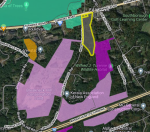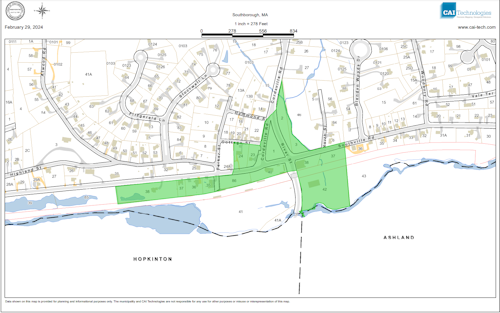Above: Planning Board members voted not to further confuse voters by making a quick push to revise a map that has already had multiple revisions in order to try to pass a new zoning bylaw this spring. (image of the most recent, but non-compliant, map from the Town website.)
Last night, the Planning Board voted not to bring the MBTA Communities zoning Article to Annual Town Meeting this month.
The decision was in response to learning that the district mapped for the area within a ½ mile of the train station doesn’t comply with the regulations under the state law.
To meet the requirements, the board would have to expand the map and/or change the underlying “dimensional” zoning restrictions (for setbacks, heights, etc.) to give more leeway for higher density development.
[Editor’s Note: For readers who haven’t been following the details of MBTA Zoning requirements, you can read more background here.]
At the opening of the public hearing on the bylaw last week, member Marnie Hoolahan noted that staff would be following up with the engineering consultants on a compliance question raised. Advisory Committee Chair Andrew Pfaff asked them to double check that the commuter rail district would really allow the potential for up to 150 units to be built.
At the time, the board had been previously assured by Bohler Engineering that their map was compliant. That turned out to be incorrect.
On Monday night, before getting in to what happened, the board focused on whether to try to quickly fix the problem or push the Article to a future Town Meeting. They unanimously agreed that it would be a mistake to bring the Article forward this month. The consensus was to pursue a Special Town Meeting in the fall.
Hoolahan did hope that the board would be allowed to preview the initiative in a presentation to voters at Annual Town Meeting.
At the same time, she also asked to pursue appealing to the state for a change to the Town’s requirements. The member said that she didn’t see how they could zone for the density of 150 units in that area of town with its small lots and so many historic homes.*
Member Lisa Braccio agreed, but suggested they should ask for a 3-6 month extension, since they had based work on mistakes in the state’s model.
Consultant Zack Richards of Bohler clarified that it wasn’t the state’s error. Bohler had been misinterpreting the compliance model’s results. (Scroll down for more on the error.) Over the past week, they worked with MassHousing Partnership to get clarity on how to correctly interpret the model.
The Town needs to make changes that would allow about 75 more units than the current draft map and bylaw would cover.
Richards spun that they were very close to meeting the requirements. He stated that “With some open mindedness and some adjustments to the dimensional regulations we’re not that far off.”
Bohler had prepared and emailed ot the board options to consider. The majority of the board made clear they weren’t ready to look at Bohler’s recommendations last night.
Referring to details in emails (which weren’t posted for the public), member Debbie DeMuria rebutted the idea that maps were close to being ready:
This isn’t just a map we’re playing around. This is real life. . .
I see four stories, and I see things like that and I can’t deal with that in this community. I don’t think that’s fair. We never told anyone in this community that we’d be doing anything like that. I know and appreciate that as an engineer you’re looking for solutions. Some of these solutions are not going to fit Southborough.
She wasn’t alone. Hoolahan said that not having reviewed the materials, she wasn’t comfortable presenting them to the public yet. She recommended that members should review Bohler’s details offline and come to next Monday’s continued hearing prepared to discuss.
The board supported that and also appeared to support her assumption that they will need to reevaluate the entire area to redraw a map.
Resident Ben Cohen commented that he hoped the board would present a lot of different ways to potentially comply. He opined that the prior approach of “whittling away a at a single perfect zone” hadn’t worked out.
How did the error happen (and could it be repeated)?
Richards justified the compliance error as a result of Bohler becoming “too compressed” when they strove to meet the board’s aggressive timeline. He said he wasn’t “pointing fingers”, but in hindsight they should have told the board that they couldn’t meet their deadlines when they didn’t get the feedback in the time originally expected.
After being pressed multiple times for details, Richards explained the misunderstanding.
To comply with state regs, the commuter rail overlay district should allow for at least 20% of the 750 minimum potential units required for the overlay districts for the whole Town.
When the consultant entered all of the data, including underlying zoning restrictions, the tables showed results for that district with figures of 20% or higher. They read that as meeting the 20% threshold.
Full compliance with the requirement would actually read as 100%. So the 49% compliance calculated for the district, meant they were over 50% shy of meeting the requirement.
Pfaff later joined the zoom meeting to comment. He claimed that the issue had been raised with Bohler back in January. He also referred to the model as self evident.
In his explanations, Richards pointed to underlying zoning issues with minimum lot sizes. Later, commenter Jack Bartolini said that many of the old parcels on that side of town are too small to conform with the current zoning.
The board intends to take advantage of time between now and a fall Town Meeting to get official feedback from the state. If the Town submits its proposed district and bylaw, the state will report back within 90 day on whether or not it meets the criteria.
As a commuter rail community, the deadline for the Town to pass a compliant zoning law is the end of this year. Braccio suggested that they shoot for passing it at a September Town Meeting so that if it fails, they can try again in November.
At the end of their meeting, Chair Meme Luttrell confirmed that she would start looking into steps for appealing to the state.
Push to consider changes to other maps
As long as they are reconsidering that map, the board heard from members of the public that there are parcels they should reconsider for the other districts in town. Comments included that incorporating the Madison Place 40B development as part of the zoning maps doesn’t meet with the spirit of the law designed to increase housing opportunities.
 Hoolahan mentioned that over the past week, she visited Bob Heavey’s property with Town Planner Karina Quinn. Heavey has been publicly pushing the board to include his property on Route 9.
Hoolahan mentioned that over the past week, she visited Bob Heavey’s property with Town Planner Karina Quinn. Heavey has been publicly pushing the board to include his property on Route 9.
Last week, Heavey again pitched that the land is right by Walgreens and also walkable to nearby restaurants, a post office, and Fayville Park. He has been floating the idea of using 5 acres of his land for development and donating the rest of the parcel (identified as high priority for potential open space) to the Town.
At the time, Hoolahan defended the rubric the board used for selecting district maps. But she noted that one of the purpose of the public hearings is allowing the public to weigh in. If residents advocated including that parcel, the board will consider it.
Last night, Bartolini also made a pitch for reconsidering his property on Route 9 as a backup.
Earlier in the meeting, the board clarified that they don’t actually need new parcels outside of the ½ mile circle around the train station. The other two parcels more than meet the criteria.
*The Town already tried pushing back on the requirement for dense housing in that section of town. A letter explaining the issues in the area was submitted during the public comment period before guidelines were finalized. The overall public comments did result in reducing the amount of housing that had to be zoned in the commuter rail district — allowing Southborough to have 80% of its overlay districts outside of the ½ mile.


